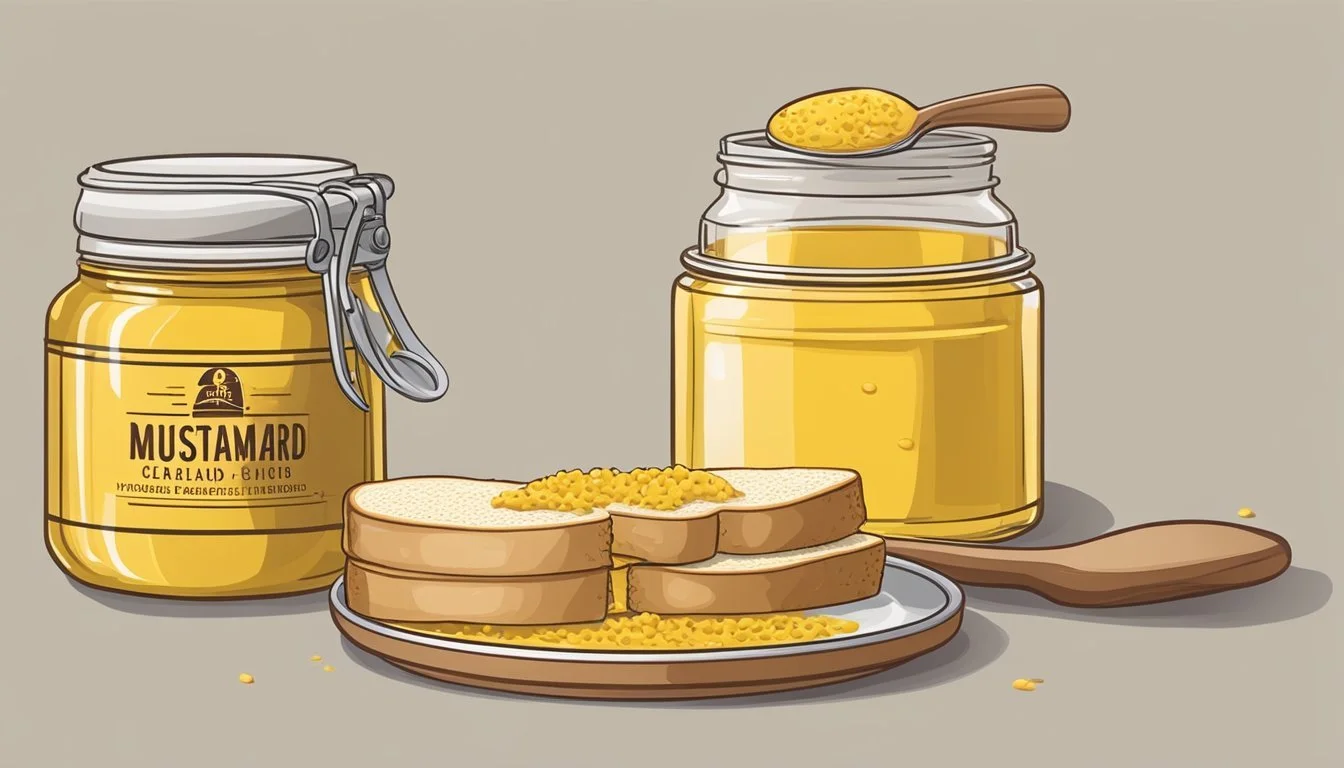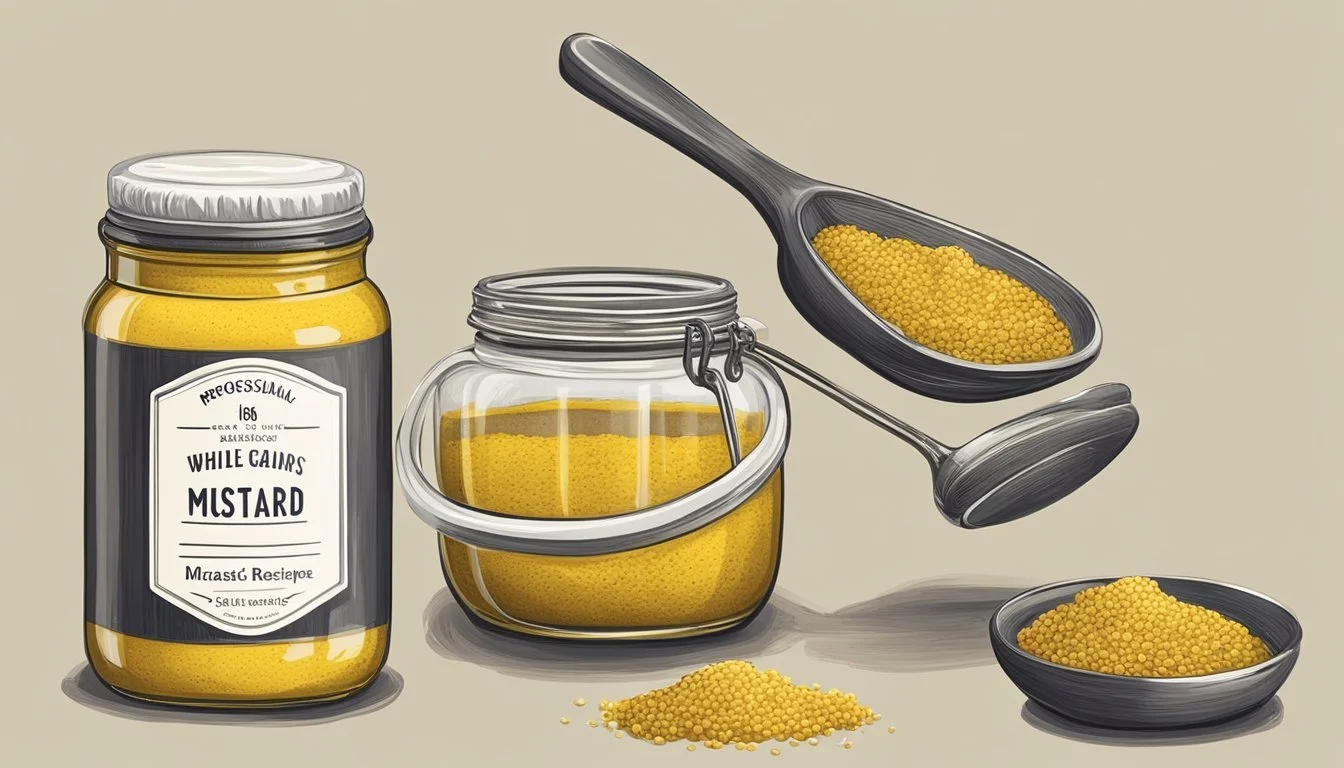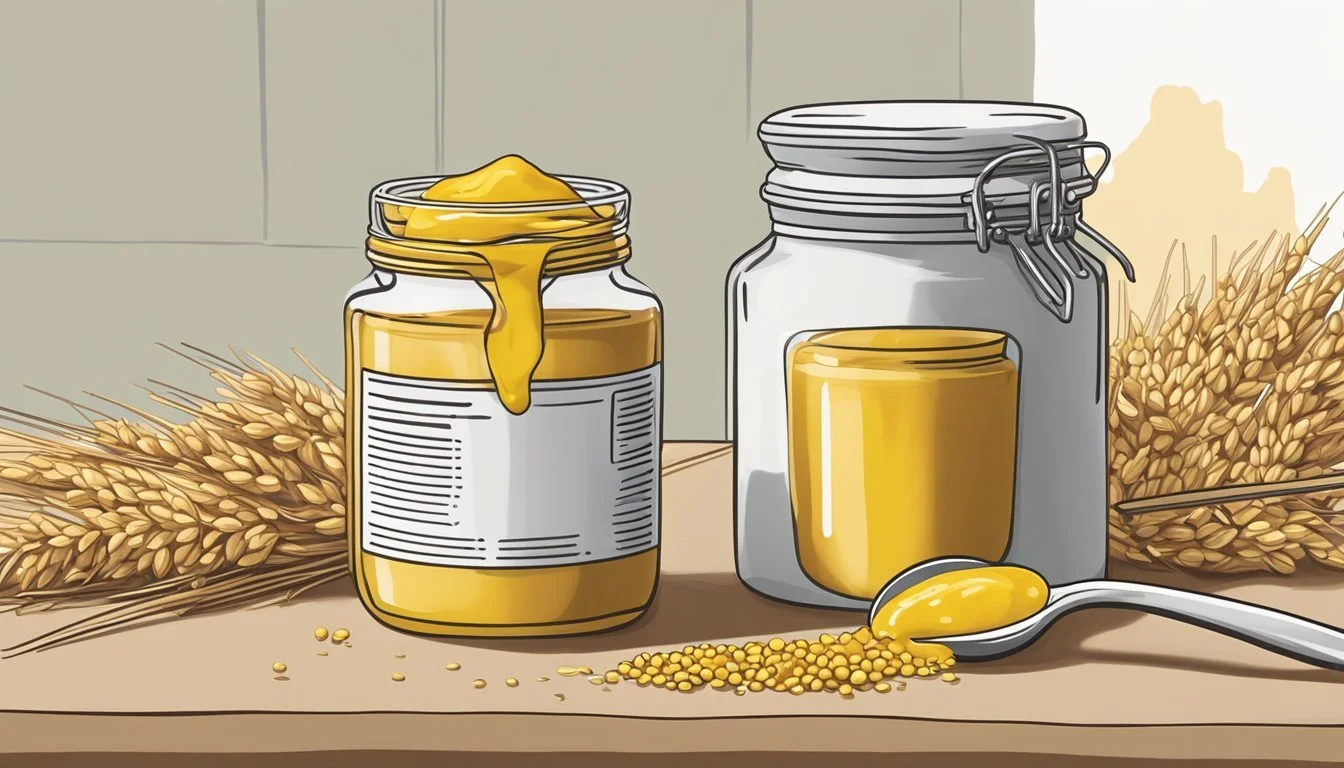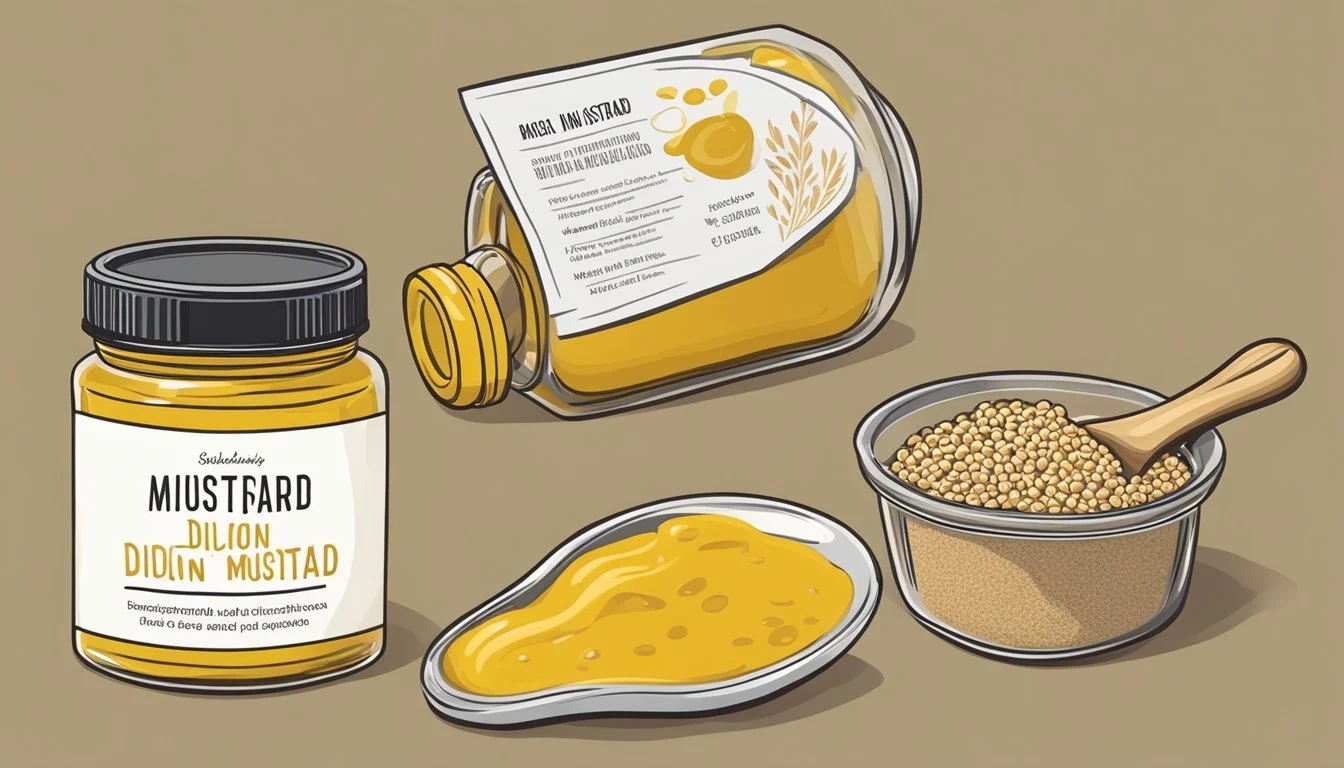How to Substitute Whole Grain Mustard for Dijon
A Simple Guide for Flavorful Swaps
Whole grain mustard and Dijon mustard are both popular condiments with distinct flavors and textures. While both are derived from mustard seeds, Dijon mustard originates from the Dijon region of France and is known for its smooth consistency and sharp, tangy flavor. Whole grain mustard, on the other hand, contains partially ground mustard seeds, giving it a coarse texture and a slightly less pungent taste.
When a recipe calls for Dijon mustard, but it's not available, whole grain mustard can serve as an effective substitute. The substitution works especially well in recipes where mustard is not the primary flavor, such as dressings, marinades, and sauces. Whole grain mustard can also add an appealing texture and aesthetic to dishes.
To substitute whole grain mustard for Dijon mustard, a one-to-one ratio is typically used. This means if a recipe requires one tablespoon of Dijon mustard, one can use one tablespoon of whole grain mustard as a replacement. However, because whole grain mustard is milder and more textured, personal preference may dictate using slightly less than the recipe calls for, adjusting to taste.
Understanding Mustard Varieties
When substituting whole grain mustard for Dijon mustard, one must consider the distinctive qualities of each. Different mustard varieties offer varying textures and flavors, influencing how they can be used interchangeably.
Characteristics of Dijon Mustard
Dijon mustard originates from Dijon, France, and is known for its smooth texture and sharp, tangy flavor. A classic Dijon mustard is made from brown mustard seeds, white wine, and salt. The seeds are finely ground, resulting in a creamy consistency. The addition of wine instead of vinegar imparts a milder acidity while maintaining a complex flavor profile that is both spicy and a bit earthy.
Texture: Smooth, creamy
Flavor: Sharp, tangy
Composition: Brown mustard seeds, white wine, salt
Properties of Whole Grain Mustard
Whole grain mustard, also known as "grainy mustard," is easily distinguished by its coarse, textured appearance. It consists of partially ground or whole mustard seeds, which impart a robust flavor and a rustic texture. Vinegar is typically used as the preservative and the acidic component in whole grain mustard, and it can include a variety of seasonings for different flavor notes.
Texture: Coarse, grainy
Flavor: Robust, less spicy than Dijon
Composition: Partially ground or whole mustard seeds, vinegar, salt
When substituting, it is essential to note that while whole grain mustard can mimic the flavor of Dijon, the texture will be noticeably different, potentially affecting the final dish's presentation and mouthfeel.
Culinary Uses of Mustard
Mustard plays a versatile role in culinary practices, serving as a condiment, ingredient in marinades and dressings, and enhancing flavor profiles in various dishes.
Applicability in Recipes
In the realm of recipes, mustard is a key player. It isn't just a topping; it's an integral component that brings depth and zest to an array of dishes. For burgers and hot dogs, whole grain mustard can be replaced with Dijon mustard to complement the richness of the meat with its sharp and tangy taste. When it comes to meat and vegetables, Dijon mustard serves not only as a seasoning but also as a binder for crusts and coatings, ensuring that every bite is packed with flavor.
Mustard in Marinades and Dressings
Marinades: Mustard is a crucial ingredient in marinades, imparting a tangy depth to meats. When substituting whole grain mustard with Dijon mustard in a marinade, the latter imparts a smoother texture and a more piquant flavor, which is particularly beneficial for tenderizing and flavoring cuts of meat.
Dressings: In dressings, the emulsifying properties of mustard help to blend oil and vinegar seamlessly. Dijon mustard can easily stand in for whole grain mustard, giving a creamier consistency and a balanced, sharp taste, perfect for dressing salads or as a base in sauces.
Substituting Mustards
When one aims to replace whole grain mustard with Dijon mustard, they must pay attention to the flavor profile and texture of the substitutes to achieve a similar culinary effect.
Adjusting Taste and Texture
Substitutes for whole grain mustard should ideally keep the spicy flavor and tangy notes intact. Dijon mustard, known for its smooth consistency and sharp taste, can be replaced using a 1:1 ratio with:
Stone-ground mustard: It offers a similar texture to whole grain mustard with a slight spike in spice, maintaining that desired grainy texture.
Yellow mustard: Although milder, it provides tangy flavor and can work seamlessly in recipes at a 1:1 ratio.
To mimic the traditional kick and heat of whole grain mustard, condiments like horseradish may be used sparingly, considering its more intense pungency.
Considerations for Flavor Balance
In any recipe, balancing flavors is crucial. A chef must consider the following when using substitutes:
The mildness or intensity of the mustard: For instance, yellow mustard is milder, so one might need to adjust the quantity to match the robust flavor of whole grain mustard.
The addition of sweetness: If opting for honey mustard, remember it adds sweetness, which may alter the flavor profile of the dish.
The coarseness of the seeds: In dressings and marinades where texture is noticeable, stone-ground mustard or even a homemade blend of Dijon with added mustard seeds could provide a suitable fix.
Additional Ingredients
When substituting whole grain mustard for Dijon mustard, it is important to consider the balance of flavors that additional ingredients such as sugar, salt, and spices bring to the dish.
Roles of Sugar, Salt, and Spices
Sugar: The addition of sugar can offset the tartness inherent in mustard, and enhance the overall sweetness of a recipe. When Dijon mustard is replaced with whole grain mustard, which often has a less pronounced sweet profile, a cook may choose to add a pinch of sugar to achieve a similar level of sweetness.
To Consider: Sugar types can vary from white granulated sugar to brown sugar or honey.
Application: A small amount of sugar can be added gradually until the desired sweetness is reached.
Salt: Salt is used to amplify flavors and add depth. Whole grain mustard typically contains less salt than Dijon mustard, so users may need to adjust the salt content in their recipes accordingly.
To Consider: The type of salt used (kosher, sea salt, iodized) can affect the final flavor.
Application: Incremental addition of salt is recommended to avoid overpowering the dish.
Spices: Spices play a pivotal role in the flavor profile of mustards. Whole grain mustard has a prominently sharp and pungent taste due to the use of partially ground seeds. Supplementing with a careful selection of spices can mimic the flavor complexity of Dijon mustard.
Common Spices: Turmeric, garlic powder, paprika, and black pepper.
Special Notes: Horseradish or wasabi can be introduced for an intensified sharpness, often desired in the absence of Dijon mustard's complex flavor.
By carefully adjusting these additional ingredients, the desired flavor balance can be achieved when whole grain mustard stands in for Dijon mustard.
Health and Nutritional Information
When substituting whole grain mustard for Dijon mustard, consumers often consider the health and nutritional differences between these two condiments. Both whole grain mustard and Dijon mustard are made from mustard seeds, which implies they share some nutritional attributes. However, their preparation methods result in distinct profiles.
Whole grain mustard typically contains:
Calories: Relatively low in calories, contributing minimally to daily caloric intake.
Sodium: Varies by brand but can be a consideration for those monitoring salt intake.
Protein: Provides a small amount of protein.
Fat: Low in fat, with minimal contribution to total fat intake.
Carbohydrates: Contains a moderate amount of carbohydrates.
Fiber: The seeds present may offer dietary fiber, beneficial for digestion.
On the other hand, Dijon mustard generally offers:
Calories: Similar to whole grain mustard, it is low in calories.
Sodium: May contain a higher sodium content compared to whole grain mustard.
Protein: Also provides some protein.
Fat: Low in fats, aligning with whole grain mustard.
Carbohydrates: Carbohydrate content is comparable to that of whole grain mustard.
Fiber: Typically lacks the fiber found in whole grain mustard due to the grinding process.
Both mustards are not significant sources of inflammation and can be included in anti-inflammatory diets due to their low-calorie, low-fat profile. However, the texture and presence of whole seeds in whole grain mustard might provide a slight nutritional edge in terms of fiber content. It is important for individuals to check specific brands for detailed nutritional information, as the content can vary widely.
Homemade Alternatives
For enthusiasts desiring a closer approximation to Dijon mustard, sourcing ingredients to make their own condiment can yield satisfying results. Homemade options allow for adjusting the flavor profile to personal preferences while emulating the characteristics of Dijon mustard.
Making Your Own Mustard
Creating homemade mustard affords the chef complete control over the condiment's strength, texture, and nuances. Ground mustard seeds stand as the foundation of the mustard, with vinegar or even beer serving to imbue the mustard with its essential piquancy and tang. To replicate the smoothness of Dijon, the seeds may need a finer grind and a balance of liquids for a creamy consistency.
To make your own Dijon-style mustard, one could start with the following basic ingredients:
Mustard seeds: Brown for more heat, yellow for a milder taste.
Liquid: White wine or a mix of vinegar and water; beer is also an option for a distinctive flavor.
Seasoning: Salt for taste and optionally a hint of honey or sugar for sweetness.
A simple process could look like this:
Grind the mustard seeds coarsely.
Mix them with the chosen liquid until a paste forms.
Season the mixture and allow it to sit for a few days for flavors to meld.
Remember, the homemade mustard will initially be more intense and will mellow over time. Adjustments in seed type, the ratio of vinegar or beer, and additional seasonings can all tailor the homemade batch back towards the Dijon mustard flavor profile.
The beauty of the homemade approach is its adaptability; one's culinary creativity can guide the journey from raw seeds to a spreadable, flavorful mustard ideal for an array of dishes.
Mustard in Various Cultures
Mustard, a condiment with rich historical roots and diverse preparation methods, has evolved distinctly across cultures. It not only serves as a flavor enhancer but also embodies the culinary traditions of various regions.
German Mustard
In Germany, mustard is known as "Senf" and is an indispensable part of their cuisine. There are several regional variations, but typically, German mustard is less acidic and may range from sweet to spicy. Bavarian sweet mustard, for instance, pairs excellently with the traditional white sausage (Weisswurst). It's made from coarsely ground seeds, which gives it a similar texture to whole grain mustard.
Types of German Mustard Distinct Characteristics Medium (Mittelscharfer) Perfect balance of sweetness and sharpness Sweet (Süßer Senf) Notably sweet, often with a darker color Hot (Scharfer Senf) Intense, sharp heat
American Mustard Varieties
American mustard's origins are both local and influenced by other cultures, making the American version an invention in its own right. Classic American mustard typically seen at ballgames and picnics is known for its bright yellow color, derived from turmeric, and its mild, tart flavor. It was popularized by Francis French who capitalized on the idea that mustard doesn't have to be hot. Moreover, America also produces whole grain mustards that mirror European styles but often with a distinct twist incorporating different local ingredients like honey or various types of vinegar to create unique blends.
Popular American Mustard Varieties Key Ingredients Yellow Mustard Turmeric, which gives the yellow color Spicy Brown/Deli-Style Mustard Coarser grind, with a spicier kick Honey Mustard Sweetness from added honey
While English mustard is known for its strong, sharp flavor and bright yellow hue, both German and American mustards present a rich tapestry of tastes, from mellow sweetness to piquant spice, reflecting their cultural diversity and culinary innovation.
Practical Tips for Substitution
When substituting whole grain mustard for Dijon mustard, the goal is to achieve a similar flavor profile and texture that complements the dish. One needs to consider the potency of the mustard and individual taste preferences.
Adjusting Quantities and Measurements
A 1:1 substitution ratio is generally effective when replacing Dijon mustard with whole grain mustard. However, users may find the need to alter this ratio slightly based on the strength of the whole grain mustard's flavor, which can vary by manufacturer. For recipes that rely heavily on the smoothness of Dijon, it's advisable to be cautious with a coarse-textured substitute.
Basic Substitution Ratio: 1 tablespoon Dijon = 1 tablespoon whole grain
Fine-tune Adjustment: Start with slightly less whole grain mustard and add incrementally.
Taste Testing and Personal Preference
Personal preference plays a pivotal role in adjusting the quantity of whole grain mustard used. Before adding the substitute to their recipe, one should taste test the mustard to understand its flavor intensity.
Conduct a taste test with a small amount.
Adjust based on whether a milder or stronger mustard flavor is desired.
Remember, the overall aim is to ensure that the condiment remains accessible and affordable without compromising on the dish's intended taste and quality.
Conclusion
In culinary practices, the interchangeability of whole grain mustard and Dijon mustard has practical implications. Dijon mustard is a suitable stand-in for whole grain mustard because both possess a tangy flavor profile with a distinct sharpness. The classic 1:1 substitution ratio serves as a starting point, acknowledging that personal taste preferences might dictate adjustments.
Texture is a notable differentiator between the two. Dijon mustard offers a smoother consistency, whereas whole grain mustard provides a coarse, grainy feel. Chefs may consider the desired texture in their dishes before making a switch.
Substituting Dijon for Whole grain Mustard:
Ratio: 1:1 substitution
Texture Considerations: Smoother for Dijon; Coarser for Whole Grain
Taste Adjustments: Make to suit personal preferences
Consumers should remain mindful of the nuances in flavor when substituting Dijon mustard in recipes calling for whole grain mustard. If a recipe is particularly contingent on the mustard's texture, additional tweaks may be necessary to achieve the intended outcome.
Those seeking alternatives to whole grain mustard have several other options. Stone ground mustard, horseradish, and even a homemade blend of seeds and spices can offer suitable replacements that cater to diverse flavor and textural preferences. Each alternative brings its own unique qualities to the palate and should be carefully considered in the context of the recipe at hand.








